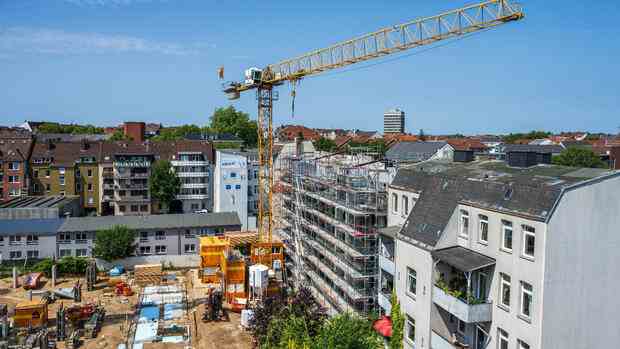At the end of 2022, new business in private mortgage lending fell significantly compared to the previous year. In November, the minus was almost 40 percent.
(Photo: IMAGO/penofoto)
Frankfurt The business with private real estate loans collapsed last November – even more than in the two previous months. The completed new financing volume was 13.6 billion euros and thus 39 percent below the previous year’s level, determined the analysis company Barkow Consulting.
That is the lowest level since June 2011. Last March, the business had reached a record value of a good 32 billion euros. Compared to this peak, the decline is now almost 60 percent.
As early as October, the volume of fresh loans fell by 34 percent compared to the previous year, and by 28 percent in September, as Barkow Consulting reported with reference to data from the European Central Bank (ECB) and the Bundesbank.
The sharp decrease shows how the increased building interest rates, the increased material prices and the general uncertainty are affecting real estate financing. According to FMH-Finanzberatung, construction interest rates for loans with a ten-year fixed interest rate have risen to almost four percent, and at times they were even a good four percent. This is the highest level since 2011 and a fourfold increase since the beginning of the year.
Top jobs of the day
Find the best jobs now and
be notified by email.
The ECB has raised interest rates several times since July. The interest rates for real estate purchases, which had been very low for a long time, also increased significantly.
Decline in mortgage lending hits banks and savings banks
The weakness in mortgage lending hits German banks and savings banks: At 43 percent, private real estate loans make up the largest share in the loan book of German financial institutions.
>> Read also: These are the seven most important trends for the real estate market in 2023
The credit institutions must react. The Savings Banks Association of Lower Saxony recently justified the decline in new business with, among other things, increasing equity requirements for the savings banks.
In the course of the long-term real estate boom and up until early summer 2022, banks and savings banks had granted a particularly large number of building loans. As of September, the portfolio of mortgage lending reached a high of EUR 1.55 trillion.
However, it is obvious that the portfolio increased over the year as a whole. At the Volks- und Raiffeisenbanken, the portfolio of construction financing increased by six percent, as their lobby association BVR announced on Monday. In the previous year, the increase was eight percent.
More new home savings contracts
In the meantime, many people are turning back to building savings. Since July, i.e. since the turnaround in interest rates in the euro zone, the monthly volume of newly concluded contracts has been significantly higher than in previous years.
In the third quarter of 2022, the volume even marked its highest level in ten years. The auditing and consulting firm PwC recently determined on the basis of Bundesbank data that the building savings volume of newly concluded contracts was last this high in the fourth quarter of 2012.
Building society loans are likely to be used as a safeguard in the event that interest rates on real estate loans rise again. Building society customers know exactly what the interest rate on the loan will be when they sign their contract, even though it can sometimes take over a decade before the loan is approved.
More: For whom building savings is now worthwhile again – and for whom it isn’t
